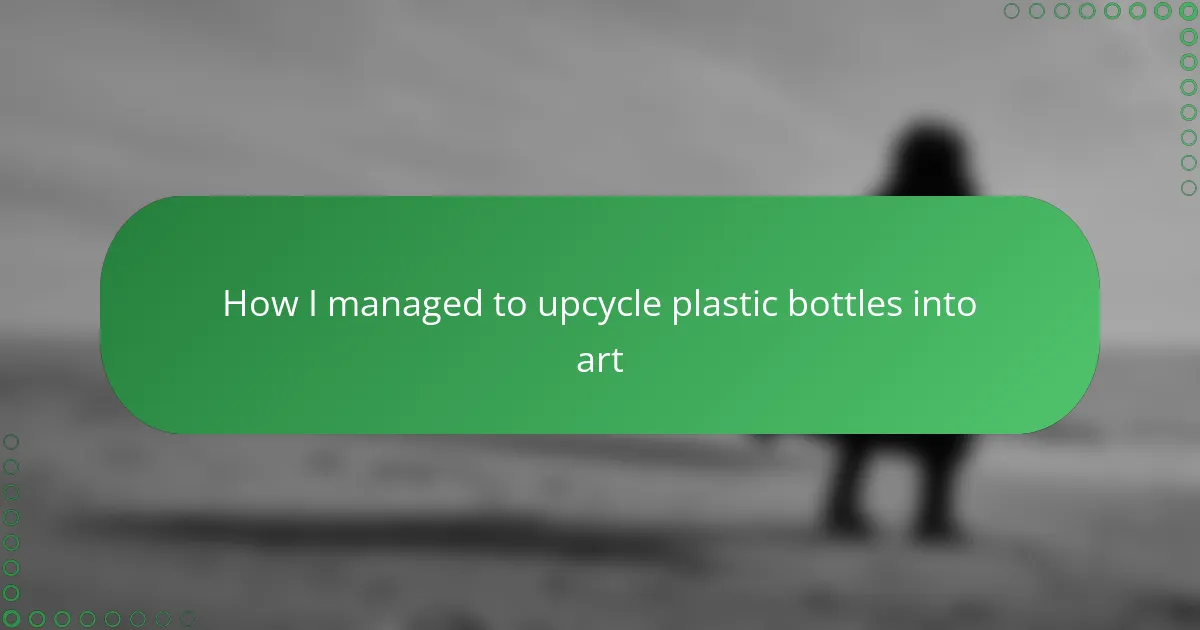Key takeaways
- Handmade paper crafts emphasize unique textures and personal touch, making each piece a distinct expression of creativity.
- Upcycling plastic bottles transforms waste into art, highlighting the potential in discarded materials through creativity and patience.
- Essential tools for upcycling include sharp cutting tools, protective gloves, and additional materials like glue and paint to enhance the crafting experience.
- Techniques such as cutting, layering, and painting are fundamental in creating visually engaging and meaningful artwork from plastic bottles.
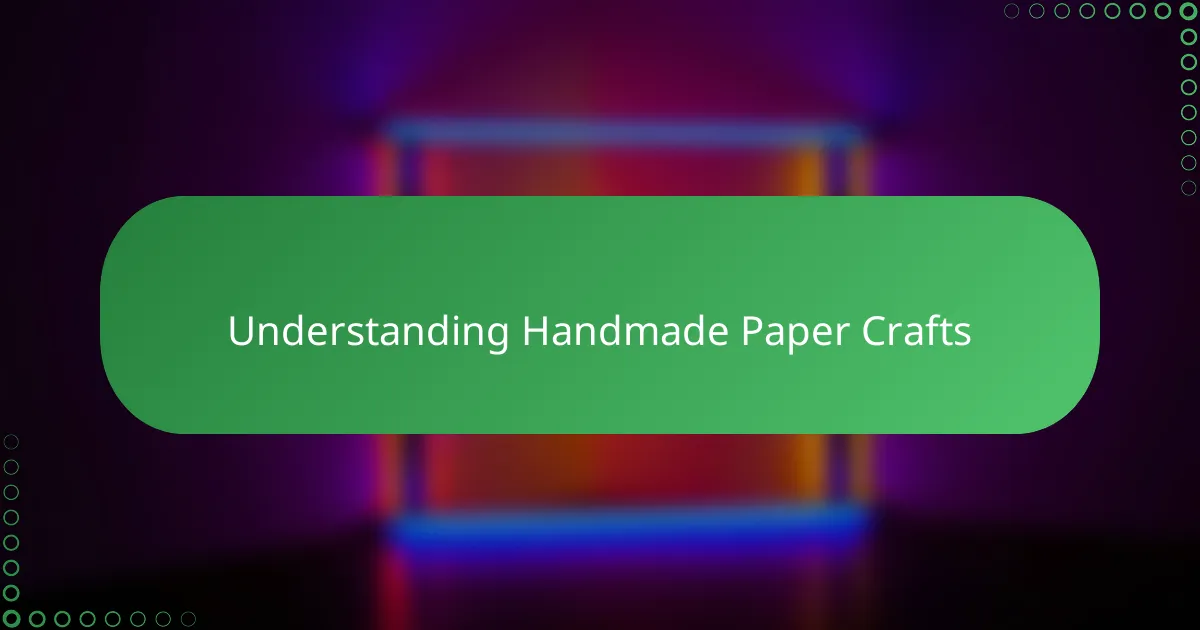
Understanding Handmade Paper Crafts
Handmade paper crafts have always fascinated me for their unique texture and the personal touch they carry — no two pieces are ever exactly the same. Have you ever noticed how the natural fibers in handmade paper create subtle patterns that machine-made paper simply can’t replicate? This organic quality gives every craft a story, making the creative process feel more intimate and rewarding.
When I first started working with handmade paper, I was struck by how much patience and care it takes to produce even a single sheet. It’s not just about the final product; it’s the tactile experience of shaping fibers, the slight imperfections that make each piece special. Isn’t that what true craftsmanship is all about — embracing imperfections rather than hiding them?
I often find that understanding the basics of handmade paper crafts opens up a whole new appreciation for the art form. It’s about more than just paper — it’s about connection, creativity, and sustainability. This mindset sets the stage for innovative projects, like turning everyday materials into something beautiful and meaningful.
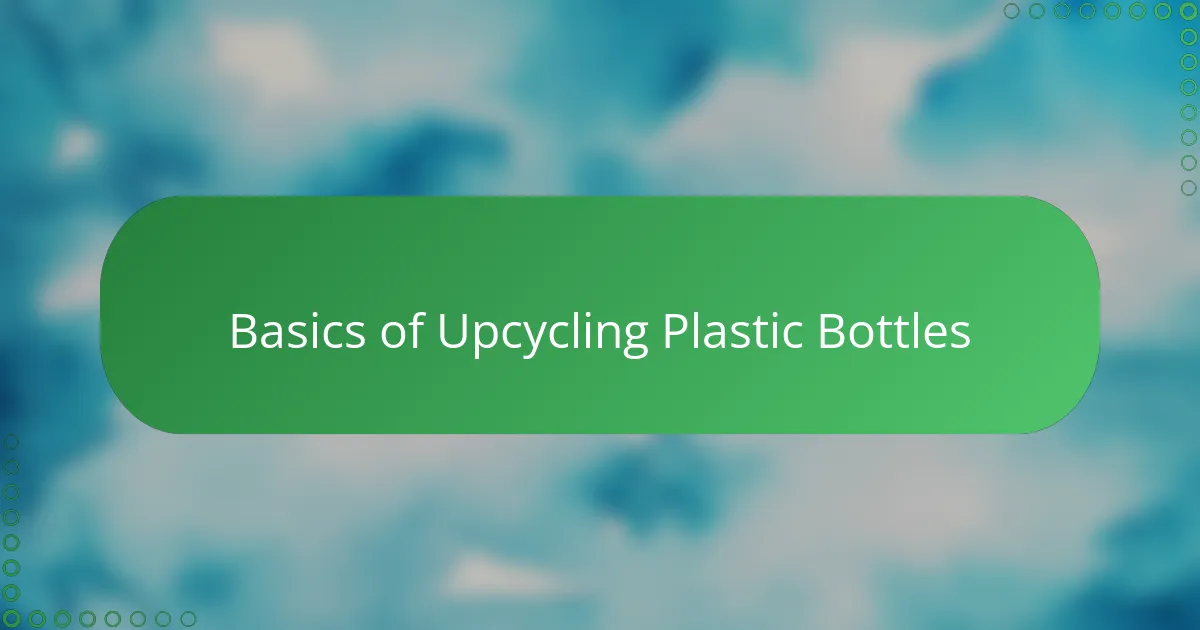
Basics of Upcycling Plastic Bottles
Upcycling plastic bottles felt like a natural extension of my love for handmade crafts. At its core, the process is about transforming something often discarded into a new form filled with potential. Have you ever held a plastic bottle and wondered how it could become more than just trash?
I’ve learned that the basics begin with a simple mindset shift — seeing plastic bottles not as waste, but as raw materials waiting for a creative purpose. Cutting, shaping, and reimagining these bottles requires a bit of patience, but it’s thrilling to watch rigid plastic take on a fresh life, much like working with handmade paper fibers.
What surprised me most was how versatile plastic bottles are once you start experimenting. From cutting patterns to layering pieces, the possibilities feel endless. It’s this blend of practicality and artistry that makes upcycling so rewarding, don’t you think?

Tools and Materials Needed
When I first gathered my tools for upcycling plastic bottles, I quickly realized that the basics weren’t complicated but were definitely essential. A sharp pair of scissors or a craft knife became my best friends—they helped me cut precise shapes without frustration. Have you ever tried using blunt scissors on thick plastic? Trust me, it’s a test of patience you don’t want to take.
Aside from cutting tools, I found that protective gloves were surprisingly important. Handling plastic edges can be tricky, and I learned the hard way that a small cut can turn a joyful project into a painful memory. Plus, having a cutting mat underneath made all the difference in keeping my workspace neat and protecting my surfaces.
As for materials, I didn’t just rely on empty bottles; hot glue, sandpaper, and acrylic paints became my go-to companions. Hot glue gave me confidence in assembling pieces securely, while sanding rough edges made every piece feel polished and safe to touch. And who doesn’t love adding a splash of color? These simple supplies transformed something ordinary into pieces I could truly be proud of.
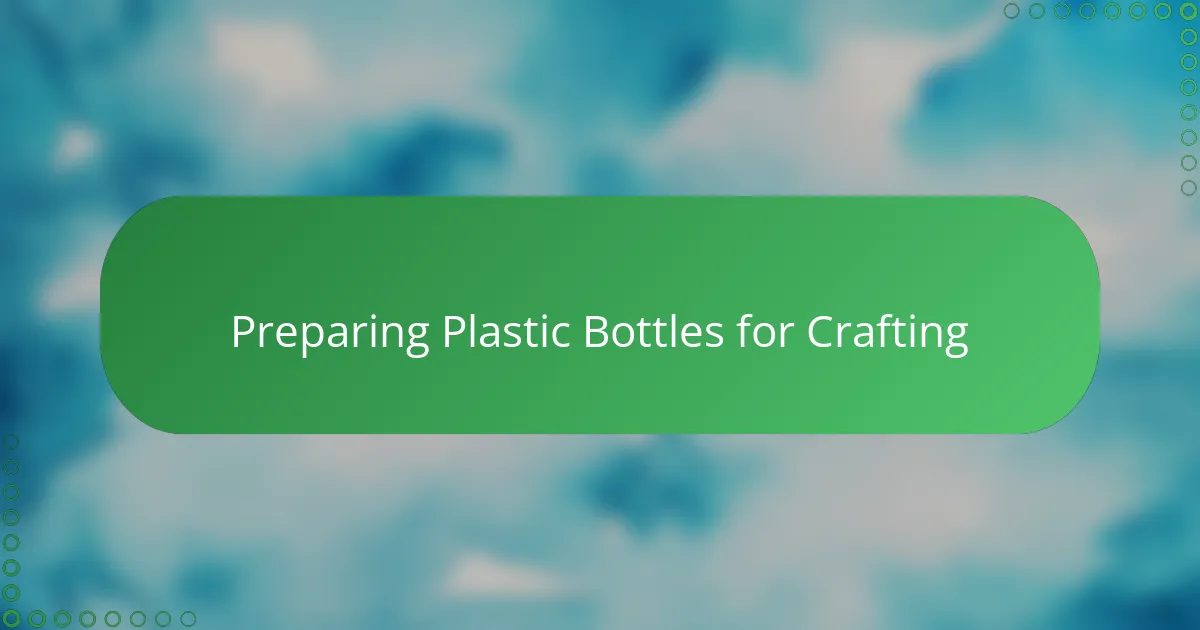
Preparing Plastic Bottles for Crafting
Preparing plastic bottles for crafting is more than just washing them out — it’s about setting the stage for creativity. I always start by removing labels and rinsing bottles thoroughly; have you noticed how any leftover glue or residue can make paints and adhesives less effective? Taking the time to clean bottles properly saves a lot of frustration down the line.
Once clean, I carefully trim bottles to the shapes I envision, but I’ve learned to go slowly, especially when cutting thicker plastic. Using a sharp craft knife helps, but there were moments I wished I had even finer tools to get those smooth edges right. Have you ever felt that mix of excitement and nervousness when making that first cut? It’s all part of the process that transforms plastic into art.
Sanding down rough edges has become a crucial step for me—not just for safety but to give each piece a finished feel. I remember the first time I skipped this and ended up with a small cut, reminding me that patience in preparation really pays off. This extra care makes subsequent painting or gluing so much easier and more enjoyable, don’t you agree?
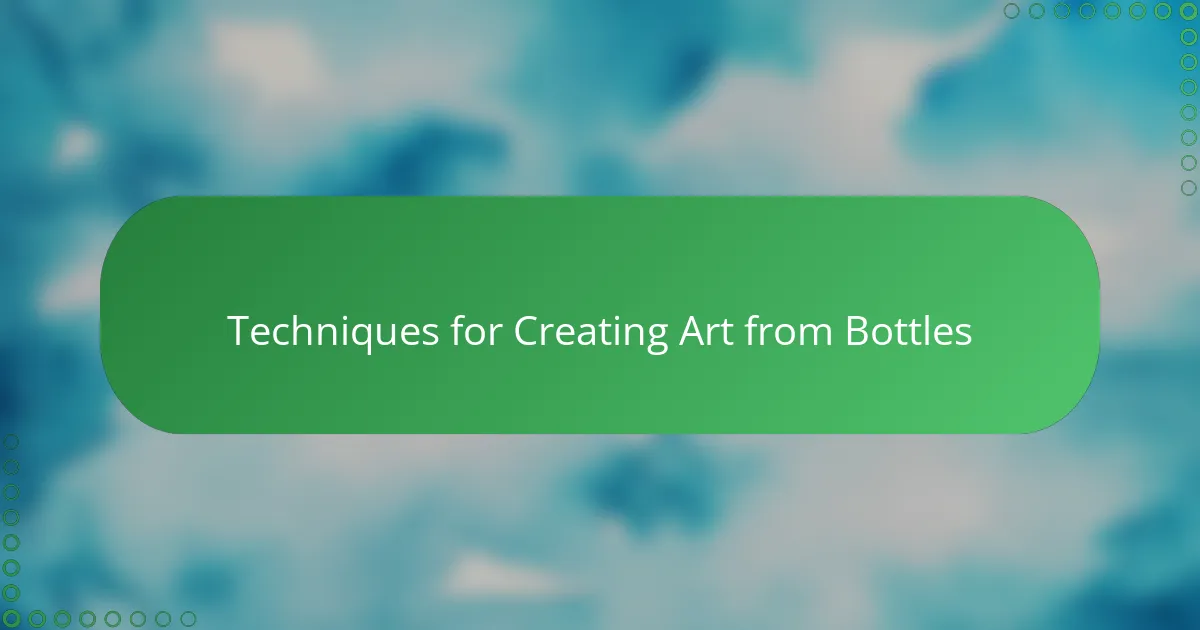
Techniques for Creating Art from Bottles
When it comes to turning plastic bottles into art, cutting and shaping are my go-to techniques. I like to start by slicing bottles into strips or interesting shapes, then bending or curling them to add dimension. Have you ever noticed how a simple curve or fold can totally change the vibe of a piece? It’s these small manipulations that bring plastic to life.
Another technique I rely on is layering. I’ve found that stacking pieces in vibrant patterns not only creates depth but also gives my work a sculptural quality. Using glue to secure these layers feels almost like puzzle-building, where each element unlocks a new visual story. Doesn’t that tactile process make crafting feel more like an adventure?
Finally, painting plays a huge role in finishing my bottle art. I use acrylic paints to add color and texture, often blending hues to mimic natural shades or bold abstract designs. Sometimes I experiment by sanding areas after drying to reveal underlying layers, giving the piece extra character. Have you ever tried transforming cold plastic into something warm and expressive just by adding paint? It’s a small magic trick that always surprises me.
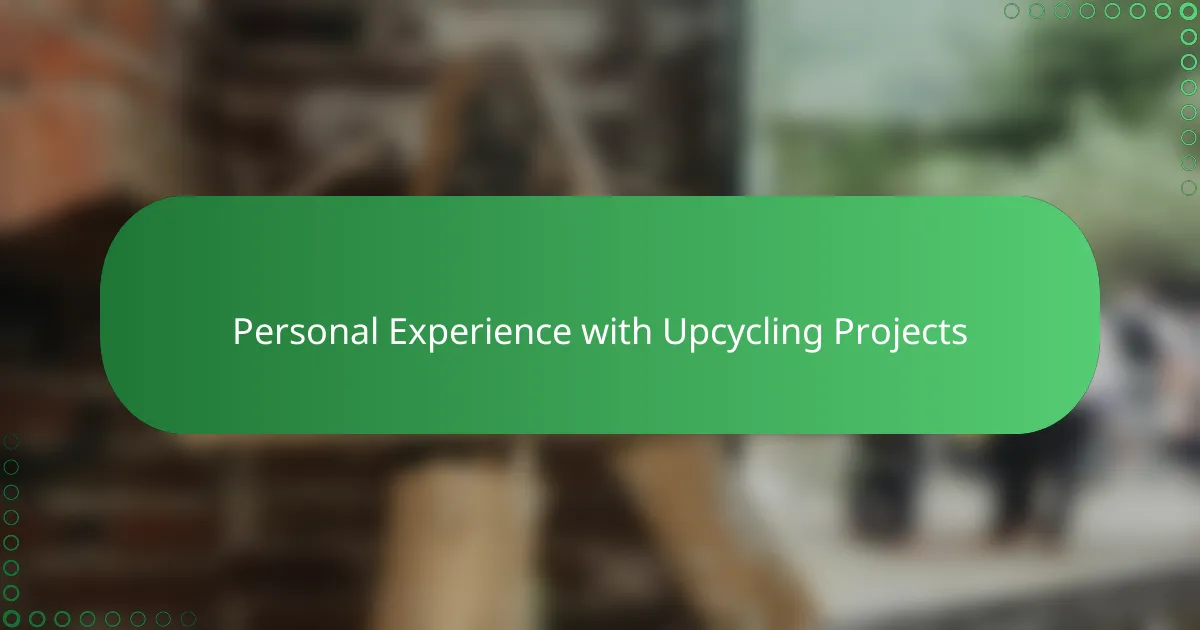
Personal Experience with Upcycling Projects
I still remember the first time I upcycled a plastic bottle—it was a mix of curiosity and hesitation. At one point, I accidentally cut myself while bending a stubborn piece, and instead of feeling defeated, that little mishap taught me patience and the importance of slow, deliberate movements. Have you ever found that the biggest lessons come from those small mistakes? For me, those moments made the crafting process feel much more personal and rewarding.
Over time, I noticed how these upcycling projects became more than just a way to reduce waste; they evolved into creative challenges that pushed my skills further. Each bottle held a new possibility, and I found myself excitedly brainstorming how to turn its shape into a component of a larger piece. Isn’t it amazing how seeing potential in something discarded can shift your whole perspective?
What really struck me was how this journey deepened my appreciation for sustainability paired with artistry. It wasn’t just about finishing a project; it was about valuing effort, reimagining materials, and celebrating imperfections—much like the handmade paper crafts I love. Have you experienced that feeling when your work becomes a reflection of your values as much as your creativity? For me, that connection made every upcycled artwork feel deeply fulfilling.
